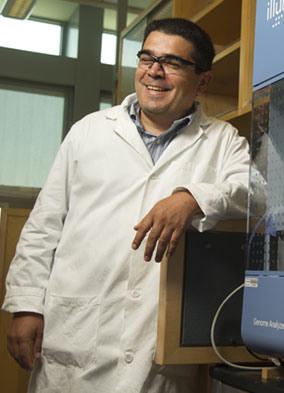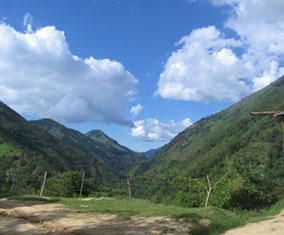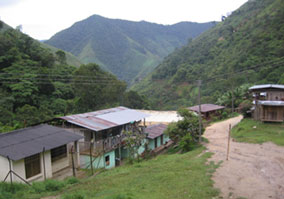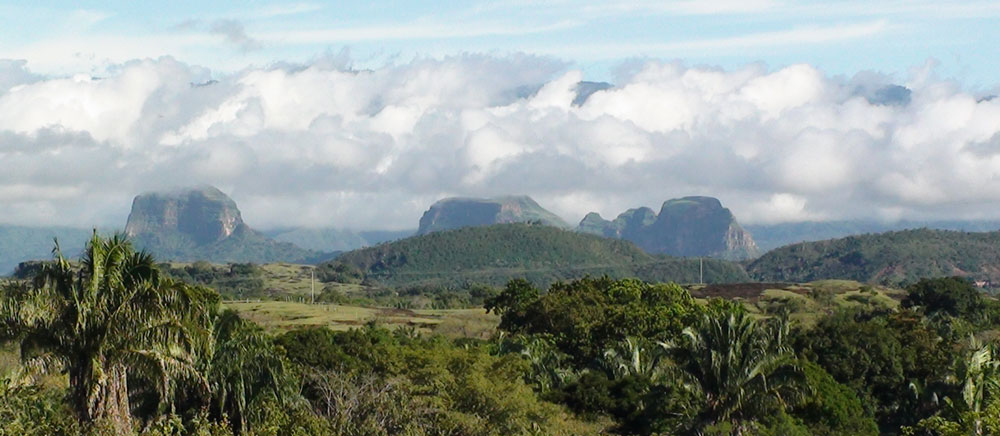
Hunting Genes
Isolated village offers cancer clues
When Luís Carvajal-Carmona left his Colombian village to study in London and Oxford, he didn’t suspect that clues to some of the world’s most vexing health problems had surrounded him all along.
In remote regions of the Andes live people who have been relatively isolated for more than 500 years. This, combined with some intermarriage and large families, makes them genetically more similar than populations almost anywhere else in the world — and a gold mine for a “gene hunter” like Carvajal-Carmona.
“Homogeneity and long lines of ancestors make it easier to find genetic mutations — or differences between individuals,” says Carvajal-Carmona, who joined the faculty last year as assistant professor in the UC Davis Department of Biochemistry and Molecular Medicine. “Few other places in the world offer the opportunity for such productive medical research studies.”
Carvajal-Carmona says knowing that a specific mutation can signal a higher risk for cancer or another disease provides valuable information that researchers anywhere in the world can use to develop genetic screening tests for cancer risk, for example, or to explore new avenues for development of targeted therapies.
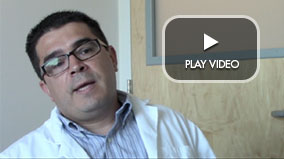
Carvajal-Carmona’s study of the genetic makeup of Andean villagers has revealed interesting background on their history and ancestry.…The region already is the center of important research into several genetic diseases.
Using blood samples collected from the Andean villagers, Carvajal-Carmona and his laboratory at the UC Davis Genome Center use a variety of high-throughput genetic analysis techniques to screen for genetic differences between individuals. Plans are in place to validate relevancy of the discoveries through partnerships with other investigators at UC Davis, Stanford, UCSF, USC and the Cancer Prevention Institute of California and to translate the findings into prevention and treatment strategies.
Carvajal-Carmona’s genomic expertise is also being used to identify genes associated with cancer therapy-related toxicity. In collaboration with Helen Chew, a medical oncologist and leader of the cancer center’s clinical breast cancer program, he will be analyzing the genome of an estimated 400 breast cancer patients from UC Davis and its affiliated cancer centers who are being treated with aromatase inhibitors. The hope is to identify genes that will enable physicians to predict which patients are at higher risk of developing debilitating muscle pain, which can hamper treatment compliance and effectiveness.
“Aromatase inhibitors are very effective in postmenopausal women with hormone-sensitive breast cancers,” explains Chew. “However, a significant number of women experience serious joint and muscle aches, which limits compliance. These are drugs that oncologists recommend women take daily for five years. If we can learn more about why some women experience these side effects and why some are spared, we can potentially tailor breast cancer therapy more effectively.”
Carvajal-Carmona believes UC Davis has the capability and the technology to find cancer mutations quickly and translate that information into real health gains. “We are optimistic that this work can rapidly contribute to better personalized medicine and global cancer health,” he says.
Genetic testing reveals surprising ancestry — and clues to disease
Carvajal-Carmona’s study of the genetic makeup of Andean villagers has revealed interesting background on their history and ancestry. Studies of maternal lines through mitochondrial DNA as it is passed from mothers to children show that ancestral mothers were primarily Native American.
More surprising is the paternal lineage. Testing in men found that almost all the genetic makeup of the Y chromosome DNA is European in origin. According to Carvajal-Carmona, it is likely that male Spanish conquistadors settled in the area, taking Native American women as wives. The male Native American population was presumably decimated from disease and conflict. Few European women came to the area, so the European men married the remaining Native American women, each passing on their genetic lines.
The region already is the center of important research into several genetic diseases. A Huntington’s disease gene mutation was found in nearby Venezuelan villages. And in the mountains surrounding Medellín, Colombia, where a 5,000-member clan has a very high incidence of early-onset Alzheimer’s disease, a large clinical trial is underway for a drug designed to prevent the onset of dementia. The common mutation responsible for the disease can be traced to a single Spanish settler who came to the region in the 1700s.
Carvajal-Carmona is optimistic that cancer research in the region will be as fruitful. In European and North American populations, where people have many different genetic variations, finding a mutation that will likely lead to cancer is like searching for a needle in a haystack. Not so in the Andean villages where there are large families with the same cancers caused by mutations passed down by village ancestors. His group already has screened 191 women with breast cancer in Colombia and identified 19 patients and families with the same genetic mutation in the BRCA1 gene. Genealogical studies indicate the mutation was likely introduced by a Spanish ancestor who settled in the Huila Province and whose descendants still live in the region.
“These are spectacular numbers,” he says. “If we studied 1,000 unselected European-American women, I can almost guarantee you that we would not find even two patients with the same mutation.”
Reducing global health disparities
Carvajal-Carmona expects that his quest for cancer-causing genetic mutations also will help fulfill a personal ambition: to reduce cancer disparities worldwide. He notes that one of science’s largest cancer genetics efforts — development of the Cancer Genome Atlas — has involved very few minorities.
“We hope that our studies will produce a body of work that will help fill this research void,” he says, adding that his group and collaborative network are leading the world’s largest breast and colon cancer genetic and genomic studies in Hispanics, both underway in Latin America.
Cancer is becoming a looming health crisis in Latin America, where rates are rising as the region develops and life expectancy increases. At the same time, few resources have been devoted to cancer screening, prevention and treatment, making death rates from the disease much higher than in Europe and the U.S. Carvajal-Carmona’s colon and breast cancer research already has helped affected family members understand the need for regular screening.
The U.S. Hispanic population is also expected to benefit from his research in Latin America, given their shared ancestry. Identification of cancer mutations common in Latin America, for instance, could help in developing rapid screening methods in U.S. Hispanics or more personalized treatments.
Carvajal-Carmona visits Latin America often, maintaining close contact with study families, through their local doctors, hospitals and academic institutions. He also is currently training three doctoral students and four master’s level students from Latin America in his UC Davis laboratory.
The scientist looks forward to collaborations with the UC Davis Comprehensive Cancer Center and the School of Medicine on cancer genomics studies in regional populations. He is planning pharmacogenetic studies for breast cancer and the role of DNA repair variation on patterns of cancer susceptibility.
“Now is the most exciting time to conduct cancer research,” says Carvajal-Carmona. “We hope that our studies will benefit the people from these remote regions, and also contribute to improving cancer prevention and treatment for people all over the world.”

